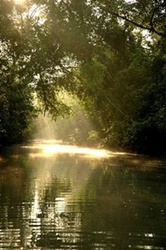One of India’s last green lungs Sunderbans being wrecked: govt study
05 Aug 2014
As India's environmental degradation continues at breakneck speed, a new officially-sponsored study has found that the mangrove forests in Bengal's famous Sunderbans region are fast losing their its capacity to absorb carbon dioxide from the atmosphere due to a rise in the salinity of water, rampant deforestation, and pollution.
 The Sundarbans forest is one of the last refuges of the Royal Bengal Tiger as well as several other near-extinct riverine species.
The Sundarbans forest is one of the last refuges of the Royal Bengal Tiger as well as several other near-extinct riverine species.
Marsh grass, phytoplanktons, molluscus and other coastal vegetation in the world's largest delta are natural absorbers of carbon dioxide. The carbons stored in the plants are known as "Blue Carbons".
The study, 'Blue Carbon Estimation in Coastal Zone of Eastern India – Sunderbans', was financed by the union government and headed by marine scientist Abhijit Mitra.
The report took three years to prepare, and it was submitted to the government last year.
The scientists involved in the study have especially sounded the alarm bell for Central Sunderbans, one of the three zones into which the forest was divided for the study; the other two being Western and Eastern.
"The situation is quite alarming, especially in the central part. The capacity of the mangrove forest, especially the Byne species, to absorb carbon dioxide, has eroded to a large extent. This will affect the entire ecosystem of the area," Sufia Zaman, a senior marine biologist who was part of the research team, told PTI.
According to Mitra, the study was conducted mainly on the Byne species of mangrove. There are 34 other species of mangroves found in the forest including Keora and Genwa.
Mitra said, "In the central part of Sunderbans near Matla, the capability of Byne trees to absorb carbons was 22 tonnes per hectare, whereas the scenario is a bit different in the eastern Sunderbans where the capacity of Byne to absorb carbons is near about 35 tonnes per hectare."
He said the situation was fraught with danger because less absorption of CO2 from the atmosphere means a higher proportion of CO2 in the atmosphere, which traps heat.
Comparing the situation with mangrove forests in Indonesia and Vietnam where too studies were conducted, Mitra said, "In Indonesia, the absorption capacity of carbons is 114 tonnes per hectare, whereas in Vietnam the quantity is 80-90/tonnes."
Going into the reasons for the scenario in the Sunderbans, a UNESCO world heritage site, Mitra said, "One of the main reasons is a sharp rise in the salinity of water in the Matla River.
"Mangroves grow in fresh water, but because of lack of fresh water the height of mangroves has come down substantially, reducing their capacity to absorb carbons," he said.
He pointed out that as fresh water is available in eastern Sunderabans, the trees there are taller.
He said the situation was better in Eastern Sunderbans where there was less human incursion, and in the western part which was fed by a regular supply of fresh water from the Hooghly river.
According to Mitra, if steps are not taken to remove the silt deposits at the meeting point of the Vidyadhari and Malta rivers, the situation may get worse.
He suggested dredging of the channel and aforestation, besides checking shrimp farming.





.webp)
















